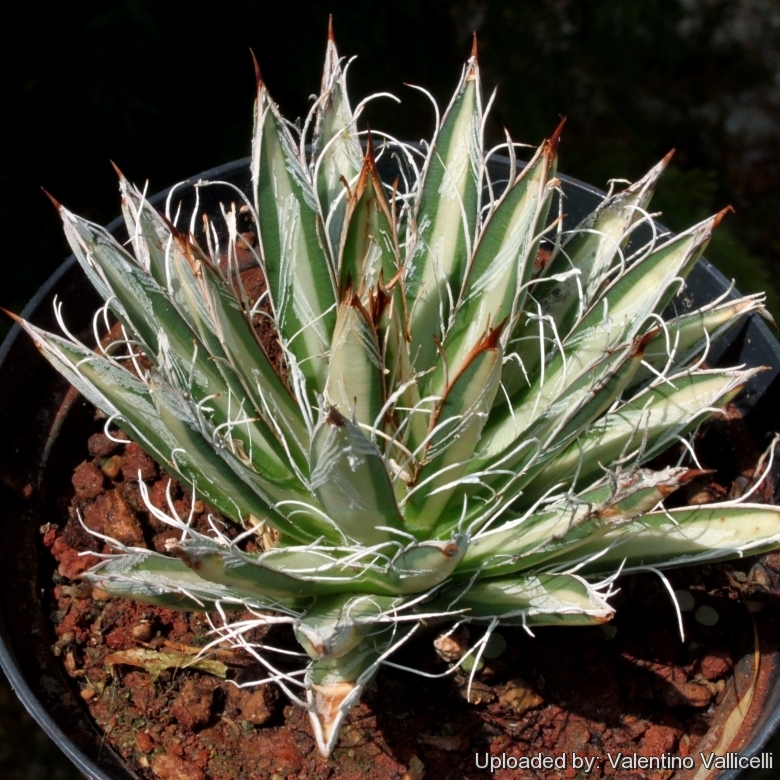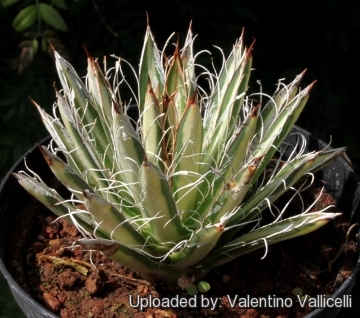
Agave toumeyana subs. bella f. variegata Photo by: Valentino Vallicelli
Origin and Habitat: Garden origin (Nursery produced cultivar)
Synonyms:
See all synonyms of Agave toumeyana
Common Names include:
ENGLISH: Variegated Toumey Agave, Variegated Toumey's century plant
Description: This is a striking variegated form of Agave toumeyanaSN|576]]SN|576]] var. bella (Toumey's Century Plant) with leaves stripped with a broad white longitudinal line, all the other characteristics are absolutely identical, namely size and form of rosettes, number and form of leaves, flowers, fruits and seeds.
Rosettes: Small, up to 20 cm in diameter, 25 cm tall, each with 100–200 leaves at maturity. Individual rosettes are small and compact, but plants sucker readily forming large clumps.
Leaves: 9 to 20 cm long, 0,6 to 2 cm wide of equal length giving the rosette a flat-topped appearance, light to dark green, with a broad white variegation on the middle, with striking white bud imprints. Leaf margins are green, smooth with a brown border and white threadlike curling white threads, replaced by denticulate margins below 1/3 of leaf. The white filaments on the leaf edges curl to resemble tight ringlets. When it gets watered on, the filaments immediately partly uncurl, but as they dry out they slowly re-curl again. Apical spine subulate, with a short narrow groove above, 1(-2)cm long, brown to greyish.
Flowers: The slender flower stalk (spike) is smaller (1,5 m tall) than in the typical variety with densely or laxly flowers in the upper ½-¼ part, pale greenish yellow flowers 1,6–2,1 cm. limb lobes 6,5–7 mm. Filaments 1,1-1,3 cm.
Blooming season: Late spring to early summer.
Remarks: The 'bella'' variety is much smaller and compact than the Agave toumeyanaSN|576]]SN|576]] (up to 20 cm tall). It has shorter, more equal, leaves with margins replaced by denticles in the lower ½ of the leaf and makes a denser rosette. It also make smaller inflorescence.
Subspecies, varieties, forms and cultivars of plants belonging to the Agave toumeyana group
- Agave toumeyana Trel.: It forms small compact rosettes, up to 30 cm in diameter, 30 cm tall, each with 100–200 leaves at maturity. Leaves are thin, stiff with striking white markings and adorned with curling white threads.
 Agave toumeyana subs. bella (Breitung) Gentry: The 'bella'' variety is much smaller and compact than the Agave toumeyana (up to 20 cm tall). It also make smaller inflorescence.
Agave toumeyana subs. bella (Breitung) Gentry: The 'bella'' variety is much smaller and compact than the Agave toumeyana (up to 20 cm tall). It also make smaller inflorescence. Agave toumeyana subs. bella f. variegata hort.: Variegated form.
Agave toumeyana subs. bella f. variegata hort.: Variegated form.
Bibliography: Major references and further lectures
1) Howard Scott Gentry “Agaves of Continental North America” University of Arizona Press, 01/Feb/2004
2) Urs Eggli “Illustrated Handbook of Succulent Plants: Monocotyledons” Springer, 2001
3) Hermann Jacobsen ”A Handbook of Succulent Plants: Abromeitiella to Euphorbia” Blandford Press, 1960
 Agave toumeyana subs. bella f. variegata Photo by: Valentino Vallicelli
Agave toumeyana subs. bella f. variegata Photo by: Valentino VallicelliSend a photo of this plant.The gallery now contains thousands of pictures, however it is possible to do even more. We are, of course, seeking photos of species not yet shown in the gallery but not only that, we are also looking for better pictures than those already present.
Read More... Cultivation and Propagation: It is a relative easy-to-grow species. Need a very well-drained, soil. It grows fairly fast in summer if provided with copious water but allows to dry thoroughly before watering again. During the winter months, one should only water enough to keep the leaves from shrivelling. They do well in hal-sun or a lightly shaded area. It is a wonderful companion plant for Echinocereus and Escobaria cacti species.
Hardiness: Agave toumeyanaSN|576]]SN|576]] subsp. bella is a very cold hardy form of the species. It is theoretically hardy to -12°C (or more) particularly when dry. However the variegated varieties are more sensitive and it is best to avoid freezing temperatures.
Propagation: It is propagated vegetatively by suckers which often are found growing around the base of the plant. Remove the basal suckers (if available) in spring or summer and let the cuttings dry for a few days before inserting in compost or by seed.











